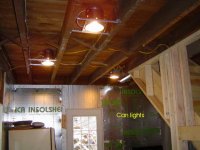clemsonfor
Super Member
I am wanting to know if what my title says has been done by anyone (the blue stuff, foam that is not drywall)? I did breif reasearch on the net and have heard both. Several with no nail pops or trouble, others say that you cant do it cause of a moisture barrier. But i see no difference than blue foam under drywall vs the plastic vapor barrior, both will trap moisture behind the drywall as both will have insulation behind them in this case?
What im proposing. In a remodel of my upstairs i want to atleast put the ridgid foam on the ceiling before i put my drywall over it. I have those ceiling tiles on it now, the 12" by 12" kind. I really dont want to pull them down so was just gonna rock over them but thinking about getting more insulation i was thinking blueboard first. There is 6" batt insulation in the void now, half the room has the ceiling attached to the roof joists and the middle is a flat part with ceiling joists (if this makes any sense). Meaning that half the room is slanted like the roof and the other has attic space over it.
I also want to think about doing it on the walls?
What are you guys thoughts?
What im proposing. In a remodel of my upstairs i want to atleast put the ridgid foam on the ceiling before i put my drywall over it. I have those ceiling tiles on it now, the 12" by 12" kind. I really dont want to pull them down so was just gonna rock over them but thinking about getting more insulation i was thinking blueboard first. There is 6" batt insulation in the void now, half the room has the ceiling attached to the roof joists and the middle is a flat part with ceiling joists (if this makes any sense). Meaning that half the room is slanted like the roof and the other has attic space over it.
I also want to think about doing it on the walls?
What are you guys thoughts?
